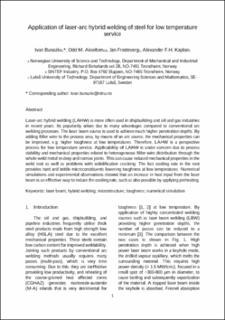| dc.contributor.author | Bunaziv, Ivan | |
| dc.contributor.author | Akselsen, Odd Magne | |
| dc.contributor.author | Frostevarg, Jan | |
| dc.contributor.author | Kaplan, Alexander F.H. | |
| dc.date.accessioned | 2020-05-14T10:26:45Z | |
| dc.date.available | 2020-05-14T10:26:45Z | |
| dc.date.created | 2019-02-05T10:24:04Z | |
| dc.date.issued | 2019 | |
| dc.identifier.citation | The International Journal of Advanced Manufacturing Technology. 2019, 102 (5-8), 2601-2613. | en_US |
| dc.identifier.issn | 0268-3768 | |
| dc.identifier.uri | https://hdl.handle.net/11250/2654431 | |
| dc.description.abstract | Laser-arc hybrid welding (LAHW) is more often used in shipbuilding and oil and gas industries in recent years. Its popularity arises due to many advantages compared to conventional arc welding processes. The laser beam source is used to achieve much higher penetration depths. By adding filler wire to the process area, by means of an arc source, the mechanical properties can be improved, e.g. higher toughness at low temperatures. Therefore, LAHW is a perspective process for low-temperature service. Applicability of LAHW is under concern due to process stability and mechanical properties related to heterogeneous filler wire distribution through the whole weld metal in deep and narrow joints. This can cause reduced mechanical properties in the weld root as well as problems with solidification cracking. The fast cooling rate in the root provides hard and brittle microconstituents lowering toughness at low temperatures. Numerical simulations and experimental observations showed that an increase in heat input from the laser beam is an effective way to reduce the cooling rate, which is also possible by applying preheating. | en_US |
| dc.language.iso | eng | en_US |
| dc.publisher | Springer | en_US |
| dc.title | Application of laser-arc hybrid welding of steel for low-temperature service | en_US |
| dc.type | Peer reviewed | en_US |
| dc.type | Journal article | en_US |
| dc.description.version | acceptedVersion | en_US |
| dc.source.pagenumber | 2601-2613 | en_US |
| dc.source.volume | 102 | en_US |
| dc.source.journal | The International Journal of Advanced Manufacturing Technology | en_US |
| dc.source.issue | 5-8 | en_US |
| dc.identifier.doi | 10.1007/s00170-019-03304-1 | |
| dc.identifier.cristin | 1673437 | |
| dc.description.localcode | This is a post-peer-review, pre-copyedit version of an article. | en_US |
| cristin.unitcode | 194,64,92,0 | |
| cristin.unitname | Institutt for maskinteknikk og produksjon | |
| cristin.ispublished | true | |
| cristin.fulltext | original | |
| cristin.qualitycode | 2 | |
